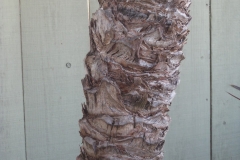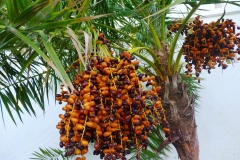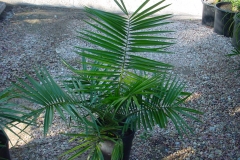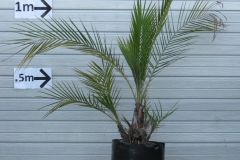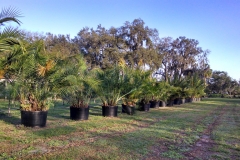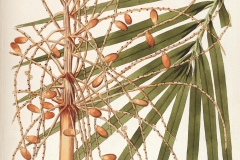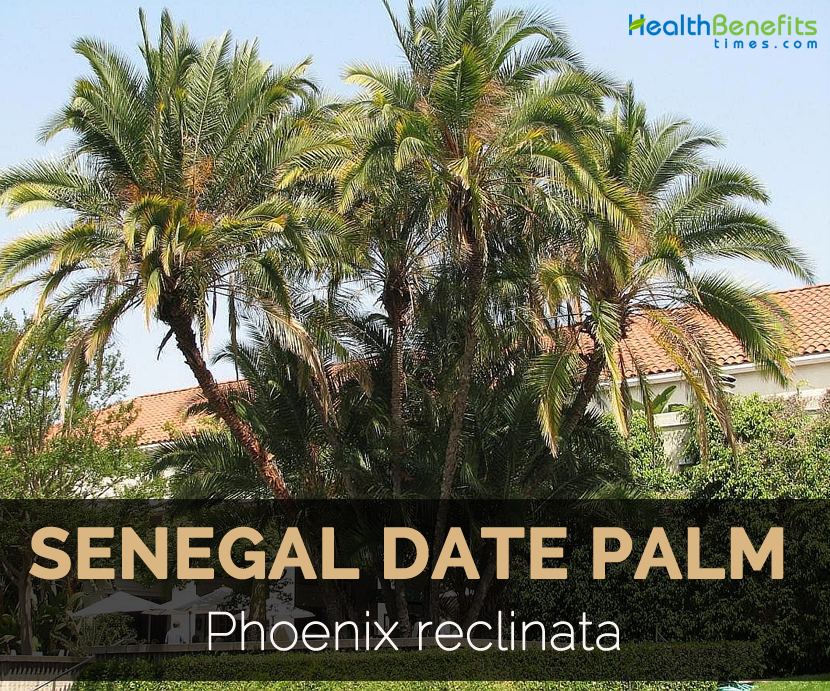
Phoenix reclinata is a dense, clumping and dioecious palm having erect or oblique stems usually 8-10 meters high having trunk diameter 15-25 cm. Bark is smooth and black ringed by distinct leaf scars and has a dense mass of roots which arises from lower part. The crown has 15 to 30 dark green to yellow green pinnate leaves. Leaf sheath is fibrous and reddish-brown. Leaves are arcuate, pinnate about 2.5-4.5 meters long and leaflets are sessile and regularly arranged distally in one plane of orientation. Leaflets are dark green, glossy, long and narrow having minutely crenulate margins. Inflorescences are branched and axillary. Staminate flowers are creamy-white. Fruit is ovoid-ellipsoid or obovoid and green that ripens yellow to bright orange about 13–20 × 7–13 mm. Seed is obovoid and 12–14 by 5–6 mm.
Leaves
Leaves are pinnate, induplicate measuring 5 meters long having arching rachis that ends in a single leaflet. Leaflets are glossy, narrow and dark green arranged in multiple planes but in a single plane near tip.
Flowers and fruit
Inflorescence is orange colored upto 1 meter long and is branched to one order. Staminate is cream colored and pistillate flowers form on different plants. Fruits are ovoid, reddish-brown to scarlet and about 1-2.5 cm long.
- Roasted seeds are used as a substitute for coffee.
- Palm wine is relished by people in Natal, Maputaland and South Africa.
- Flower buds are consumed raw or cooked as vegetable.
- Palm cabbage is consumed as vegetable.
- Dried seeds are grounded into flour.
Other facts
- Use the fibers of young and unexpanded leaves for making rope, mats, string and baskets.
- Fibers from crushed stem are used to manufacture brooms and scrubbing brushes.
- Use the mature leaves to make baskets or roofing material.
- Also the stems can be used for construction of livestock enclosures, walls, bridges, houses and fencing.
- Dye can be extracted from leaves.
- Tannins and gums are extracted from roots.
- Young leaves are bright green and older leaves are deep green.
- It propagates by seeds or division of suckers.
- It is a perennial plant having lifespan of more than 2 years.
https://www.youtube.com/watch?v=H6Jt9MBlK9o
References:
https://www.itis.gov/servlet/SingleRpt/SingleRpt?search_topic=TSN&search_value=504334#null
https://pfaf.org/user/Plant.aspx?LatinName=Phoenix+reclinata
http://tropical.theferns.info/viewtropical.php?id=Phoenix+reclinata
http://www.softschools.com/facts/plants/senegal_date_palm_facts/2653/
Comments
comments
